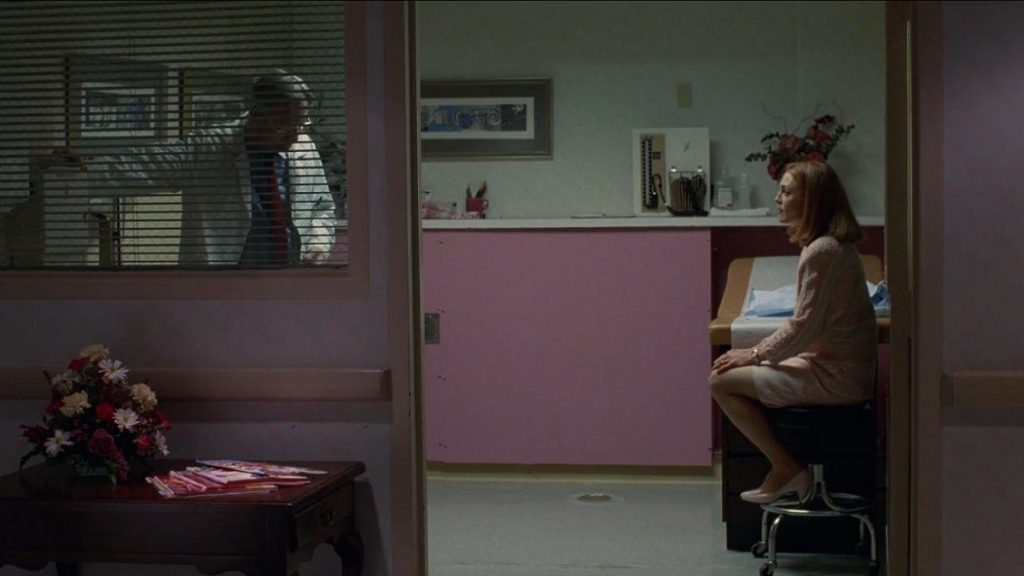Movie Monday: Film Recommendations By Our Contributors
In Safe, Todd Haynes’ 1990s masterpiece, Julianne Moore’s character Carol White is a woman pushed to the very edges of society.
Her mental illness and physical ailments are ignored. Her husband and doctors show little interest in or compassion for her. Watching Safe at any point in your life will always be a soul-shaking occasion, but for me, watching it in the early days of a lockdown enforced by a worldwide pandemic, it was (hopefully) a once-in-a-lifetime experience. Via expert filmmaking and deft handling of themes such as mental illness and pollution, Haynes creates one of cinema’s most starkly unforgettable pieces of work. Whether watched on release in 1995, during the COVID pandemic, or now, Safe is a film that will etch onto your memory forever.
By Haynes’ own admission, Safe’s themes are as relevant now as when the film was released, if not more so. Set in a superficial Los Angeles (one drenched in smog and other industrial after-effects), Safe follows protagonist Carol, who floats through her comfortable but sterile life with ease and without excitement or emotion. Haynes conjures up this stark picture of a cold society immediately. Carol is frequently framed through wide shots, amplifying her isolation against the barren backdrop of grey; heightened sound design and close-ups of product being applied to Carol’s hair intensify the poisonous aura of consumerism. The haunting drone of Brendan Dolan and Ed Tomney’s original score further amplifies the toxic, suffocating atmosphere.

Carol begins to show signs of physical illness caused by everyday items. Perhaps it is ‘environmental illness’ or multiple chemical sensitivity, or perhaps her symptoms are largely brought on by anxiety or depression. With little effort, doctors end up clueless as to how to help her, whilst psychotherapy sessions do nothing to alleviate her symptoms. It becomes clear that Carol needs help—any kind, from anyone, be it friends, family, or doctors—but the tragedy of her journey is that this assistance is non-existent, and remains so throughout.
Societies around the world are adept at shunning people with issues that are hard to understand; it is much easier for people to turn a blind eye to someone in need, especially those maligned on the edge of society. Ironically, all Carol possibly needs is to be treated with genuine affection and care. Safe is, amongst other things, a direct indictment of the consequences of such mistreatment. The film may be shrouded in a simmering, quiet dread, but its underbelly is fierce and angry.
Safe is also one of the most effective and understanding portrayals of mental illness ever put to screen. Carol’s anxiety, mysophobia (extreme fear of germs), and possible hypochondria are all severely agitated and worsen as the film progresses. Again, Haynes and cinematographer Alex Nepomniaschy rarely let the camera get too close to Carol, amplifying the isolation which directly feeds into her deteriorating mental state. This fear of falling ill and self-imposed quarantine in Safe were almost too much to bear when watching it through the lens of the COVID-19 pandemic, but I couldn’t look away, so struck was I by the intensity of the parallels between this 1995 film and 2020.
Moore’s performance is extraordinary and one of the best of the last few decades. It is one of complete truth, its realism and humanity grounded in her worrisome eyes and frightened, timid demeanour. We don’t see the ‘real’ Carol in the early stages of Safe. When she is with her husband or friends, her voice and attitude are obviously artificial, inspired by her surroundings. Carol’s façade withers in the most heartbreaking fashion as her tragic journey continues, and it’s a transformation that Moore poignantly and believably portrays.
One of the most widely used publicity images for Safe is of a person standing in a field, fully covered in clothes with no skin on show. A silent man who lives in a cult-like community which Carol eventually finds her way to, he is the epitome of what mistreatment, disregard and exploitation can drive a person to. Carol perhaps sees this man for what he represents, but at that stage in Safe, there is still no one who extends a hand to her in aid. Safe’s conclusion is one of acceptance of one’s situation, but this detracts nothing from its tragedy or despair.
We were stimulated and jolted by thrillers such as Casino, Seven and Heat in 1995, and silenced by contemplative and explosive social dramas such as La Haine. Safe however stands on its own singular plane of existence. This evocative, touching, and deeply terrifying psychological drama will torment you just as much as the cold, harsh world and people do for Carol. I have been unable to rewatch Haynes’ shattering masterpiece since seeing it two years ago, but I will experience it again very soon. Carol’s journey is so entrenched in relevance and realism that we owe her that much to revisit Safe time and time again.
Words by William Stottor
Support The Indiependent
We’re trying to raise £200 a month to help cover our operational costs. This includes our ‘Writer of the Month’ awards, where we recognise the amazing work produced by our contributor team. If you’ve enjoyed reading our site, we’d really appreciate it if you could donate to The Indiependent. Whether you can give £1 or £10, you’d be making a huge difference to our small team.
